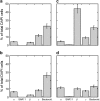Disentangling the relative influence of bacterioplankton phylogeny and metabolism on lysogeny in reservoirs and lagoons
- PMID: 21124489
- PMCID: PMC3105773
- DOI: 10.1038/ismej.2010.181
Disentangling the relative influence of bacterioplankton phylogeny and metabolism on lysogeny in reservoirs and lagoons
Abstract
Previous studies indicate that lysogeny is preponderant when environmental conditions are challenging for the bacterial communities and when their metabolism is reduced. Furthermore, it appears that lysogeny is more frequent within certain bacterial phylogenetic groups. In this comparative study from 10 freshwater reservoirs and 10 coastal lagoons, we aim to disentangle the influence of these different factors. In eight reservoirs and four lagoons, lysogeny was detected by induction assays with mitomycin C, and induction significantly modified the bacterial community composition (BCC), whereas community composition remained constant in ecosystems in which lysogeny was not observed. Among the phylogenetic groups studied, the most abundant ones were Bacteroidetes and α-proteobacteria in lagoons, and β-proteobacteria and Bacteroidetes in reservoirs. These dominant groups comprised the highest proportions of inducible lysogens. In order to unravel the effects of bacterial metabolism from phylogeny on lysogeny, we measured bacterial community physiology and the specific activities of selected phylogenetic groups. The proportion of inducible lysogens within the α- and the β-proteobacteria decreased with increasing group-specific metabolism in lagoons and reservoirs, respectively. In contrast, this relationship was not observed for the other lysogen-containing groups. Hence, both host physiology and phylogeny are critical for the establishment of lysogeny. This study illustrates the importance of lysogeny among the most abundant phylogenetic groups, and further suggests its strong structuring impact on BCC.
Figures




Similar articles
-
Metagenomic profiling of the microbial freshwater communities in two Bulgarian reservoirs.J Basic Microbiol. 2017 Aug;57(8):669-679. doi: 10.1002/jobm.201700137. Epub 2017 May 22. J Basic Microbiol. 2017. PMID: 28543439
-
Taxonomical Resolution and Distribution of Bacterioplankton Along the Vertical Gradient Reveals Pronounced Spatiotemporal Patterns in Contrasted Temperate Freshwater Lakes.Microb Ecol. 2018 Aug;76(2):372-386. doi: 10.1007/s00248-018-1143-y. Epub 2018 Jan 16. Microb Ecol. 2018. PMID: 29340714
-
Low taxon richness of bacterioplankton in high-altitude lakes of the eastern tibetan plateau, with a predominance of Bacteroidetes and Synechococcus spp.Appl Environ Microbiol. 2009 Nov;75(22):7017-25. doi: 10.1128/AEM.01544-09. Epub 2009 Sep 18. Appl Environ Microbiol. 2009. PMID: 19767472 Free PMC article.
-
Bacterioplankton community composition along a salinity gradient of sixteen high-mountain lakes located on the Tibetan Plateau, China.Appl Environ Microbiol. 2006 Aug;72(8):5478-85. doi: 10.1128/AEM.00767-06. Appl Environ Microbiol. 2006. PMID: 16885301 Free PMC article.
-
Comparative analysis of bacterioplankton assemblages from two subtropical karst reservoirs of southwestern China with contrasting trophic status.Sci Rep. 2020 Dec 18;10(1):22296. doi: 10.1038/s41598-020-78459-z. Sci Rep. 2020. PMID: 33339847 Free PMC article.
Cited by
-
Counts and sequences, observations that continue to change our understanding of viruses in nature.J Microbiol. 2015 Mar;53(3):181-92. doi: 10.1007/s12275-015-5068-6. Epub 2015 Mar 3. J Microbiol. 2015. PMID: 25732739 Review.
-
Ménage à trois in the human gut: interactions between host, bacteria and phages.Nat Rev Microbiol. 2017 Jul;15(7):397-408. doi: 10.1038/nrmicro.2017.30. Epub 2017 May 2. Nat Rev Microbiol. 2017. PMID: 28461690 Review.
-
Virus-Host Interactions Drive Contrasting Bacterial Diel Dynamics in the Ocean.Research (Wash D C). 2023 Aug 22;6:0213. doi: 10.34133/research.0213. eCollection 2023. Research (Wash D C). 2023. PMID: 37614364 Free PMC article.
-
Environmental bacteriophages: viruses of microbes in aquatic ecosystems.Front Microbiol. 2014 Jul 24;5:355. doi: 10.3389/fmicb.2014.00355. eCollection 2014. Front Microbiol. 2014. PMID: 25104950 Free PMC article. Review.
-
Tropical freshwater ecosystems have lower bacterial growth efficiency than temperate ones.Front Microbiol. 2013 Jun 21;4:167. doi: 10.3389/fmicb.2013.00167. eCollection 2013. Front Microbiol. 2013. PMID: 23801986 Free PMC article.
References
-
- Ackermann HW, DuBow MS. Viruses of Prokaryotes: General Properties of Bacteriophages. CRC Press, Inc.: Boca Raton, Florida; 1987.
-
- Alonso-Saez L, Balague V, Sa EL, Sanchez O, Gonzalez JM, Pinhassi J, et al. Seasonality in bacterial diversity in north-west Mediterranean coastal waters: assessment through clone libraries, fingerprinting and FISH. FEMS Microbiol Ecol. 2007;60:98–112. - PubMed
-
- Amann R, Fuchs BM. Single-cell identification in microbial communities by improved fluorescence in situ hybridization techniques. Nature Rev Microbiol. 2008;6:339–348. - PubMed
-
- Arutyunyan R, Gebhart E, Hovhannisyan G, Greulich KO, Rapp A. Comet-FISH using peptide nucleic acid probes detects telomeric repeats in DNA damaged by bleomycin and mitomycin C proportional to general DNA damage. Mutagenesis. 2004;19:403–408. - PubMed

